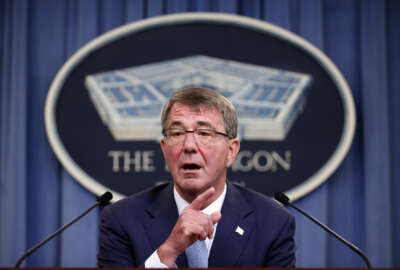
DIUx still chugging along in the Trump administration
The Defense Innovation Unit Experimental is still awarding contracts despite months of uncertainty.
The Defense Department’s fledgling innovation hub started by former Defense Secretary Ash Carter is getting serious attention from the new administration.
Defense Innovation Unit Experimental (DIUx) leader Raj Shah said he has continual dialogue with DoD leadership, which he called “positive and encouraging.”
That may come as a relief to the 45 employees working from DIUx. Those watching the organization were unsure of its future under the Trump administration.
However, Shah said the organization built to attract businesses that don’t usually associate with DoD is chugging along despite the change in leadership.
DIUx’s investments have slowed, at least monetarily. In the first two quarters of 2017 it awarded 13 agreements totaling $12.3 million.
That’s less than half of the money it awarded in the last two quarters of 2016, when it spent $36 million on contracts.
DIUx is now juggling 25 contracts that range from a communications device called Sonitus that warfighters can put in their mouth to use for communication in noisy areas to unmanned sailboats for collect intelligence.
“The awards this year have ranged from $26,000 to $2.6 million and with our outreach using reservists and new offices we’ve had 356 companies from 36 states compete for DIUx contracts,” Shah said during an April 20 conference call with reporters. “More importantly than just the numbers is what it represents in that key leaders in the department continue to see the importance of our efforts. We are moving forward on our mission with the new DoD leadership as well as support from the Hill.”
DIUx submitted a report to Congress dated Jan. 16 in which stated “DIUx is laser focused on transitioning successful prototypes into programs of record.”
Congress fenced off funds from DIUx until it submitted the report. It withheld 20 percent of DIUx’s total funds, 25 percent of DIUx’s operation and maintenance funds and 75 percent of its research and development funds until the report is filed.
DoD requested $45 million for DIUx in its 2017 budget.
Fencing off funds is “always used as a tool either to get information from the department or you are trying to get their attention that you have concerns that you think [DoD is] not fully satisfying and it’s a way to highlight it to senior leaders’ attention because presumably if there is a fence on money, the leadership of the department becomes aware of that … in the case of DIUx, it’s going to go to the [defense] secretary,” said Andrew Hunter, a senior fellow at the Center for Strategic and International Studies.
DIUx started off rocky and ended up having to do a complete overhaul in May 2016.
“DIUx right out of the gate was really trying to get its legs under it, really trying to figure out what it was,” said Stephen Rodriguez, partner at Sinewave Ventures. “It had a tough mission because it immediately had metrics imposed upon it for success and for execution. … It was also compounded by the fact that when you engage these startups the best way to have creditability is to have your own balance sheet, your own capital fund, so people actually know you have money to invest.”
That’s not DIUx; at least it wasn’t then. But companies were excited by the idea and inundated DIUx with meetings.
But when they found out there was no money to be invested the calls dropped off, Rodriguez said.
“[DIUx] just sniffed around, they’re not an actual serious customer,” Rodriguez said.
By May 2016, DIUx had put no money on contracts.
Carter put DIUx under his direction and hired Shah to run it. From there the organization began making awards.
Shah said DIUx will now focus contracts on microsatellites, small launch objects, counter unmanned aerial systems and cyber protection toolkits, the report to Congress stated.
Copyright © 2024 Federal News Network. All rights reserved. This website is not intended for users located within the European Economic Area.
Scott Maucione is a defense reporter for Federal News Network and reports on human capital, workforce and the Defense Department at-large.
Follow @smaucioneWFED





